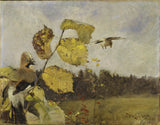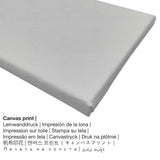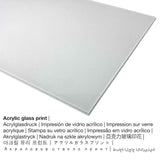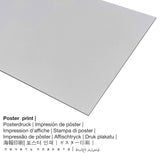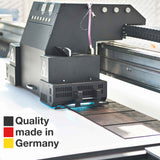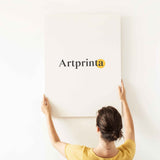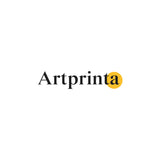Bruno Liljefors, 1886 - Jays - mbipụta nka mara mma
Ụtụ gụnyere. Mbupu gbakọrọ na ndenye ọpụpụ.
Nkọwa mgbakwunye site Nationalmuseum Stockholm (© Nwebiisinka - nke Nationalmuseum Stockholm - National Museum nke Stockholm)
English: In Bruno Liljefors painting of jays, for a second one meets a bird's gaze just before it lifts to accompany its friend over the fields. This is a frozen moment. Just as in a photograph of nature with the focus on the bird, the background is somewhat diffuse and sketchy. The beautiful and almost decorative twig that the bird is sitting on is placed to the left of the picture rather than centrally in the middle. The whole composition is asymmetrical and there is strong contrast between foreground and background. Liljefors borrowed inspiration to the somewhat unusual composition in Japanese woodcuts. Characteristic of these prints is the daring use of the surface, the absence of depth and the stylization they employ. But Liljefors never became as completely decorative and stylized in his painting as the Japanese. Rather, he created a synthesis of Japanese perspective and composition and his own realism. I Bruno Liljefors målning Nötskrika möter man för en sekund fågelns blick innan den ska lyfta och följa sin vän i flykt över fältet. Det är ett fruset ögonblick. Precis som i ett naturfotografi med fokus inställt på fågeln är bakgrunden lite diffus och skissartad. Den vackra nästan dekorativa kvisten som fågeln sitter på är placerad till vänster i bild, inte centralt i mitten. Kompositionen, bildens sammansättning, är asymmetrisk med en stark kontrast mellan förgrund och bakgrund. Den spännande och lite ovanliga kompositionen i Nötskrikan har Liljefors hämtat inspiration till från japanska trätryck. De karaktäriseras av djärva bildutsnitt, ytmässighet och stilisering. Men Liljefors blev aldrig lika dekorativ och stiliserande i sitt måleri som japanerna. Istället skapade han en sammansmältning av japanskt perspektiv och komposition och sin egen realism.
Ozi nka
| Aha nka: | "Jays" |
| Nhazi: | sere |
| Okwu nche anwụ: | nkà nke oge a |
| Nhazi oge: | 19th narị afọ |
| Year: | 1886 |
| Afọ nka: | karịa afọ 130 |
| Akụkụ izizi nka: | Ogologo: 51 cm (20 ″); Obosara: 66 cm (25,9 ″) Ekebere: Elu: 74 cm (29,1 ″); Obosara: 89 cm (35 ″); Omimi: 5 cm (1,9 ″) |
| Ụlọ ihe ngosi nka: | National Museum nke Stockholm |
| Ebe ebe ngosi nka: | Stockholm, Obodo Stockholm, Sweden |
| Ebe nrụọrụ weebụ ihe ngosi nka: | www.nationalmuseum.se |
| License: | ngalaba ọha |
| Site n'aka: | Nationalmuseum Stockholm na Wikimedia Commons |
Ozi ndabere izugbe na onye na-ese ihe
| Aha onye nka: | Bruno Liljefors |
| A makwaara dịka: | b. liljefors, Bruno Andreas Liljefors, br. andr. liljefors, Liljefors, Liljefors Bruno Anders, B.A. liljefors, Liljefors Bruno Andreas, Liljefors Bruno, Liliefors Bruno, Bruno Liljefors |
| okike nke onye nka: | nwoke |
| Obodo onye nka: | Swedish |
| Ọrụ: | onye na-ese foto, onye na-ese ihe nkiri, onye na-ese ihe |
| Obodo onye nka: | Sweden |
| Otu nka: | omenkà nke oge a |
| Afọ ọnwụ: | 79 afọ |
| Afọ ọmụmụ: | 1860 |
| Ebe omuma: | Uppsala, Uppsala, Sweden |
| Nwụrụ n'afọ: | 1939 |
| Obodo ọnwụ: | Uppsala, Uppsala, Sweden |
Nkọwapụta ihe
| Nkewa edemede: | nka nka |
| Usoro mmeghari: | dijitalụ mmeputakwa |
| Usoro mmepụta: | UV kpọmkwem obibi |
| Production: | German mmepụta |
| Stockdị ngwaahịa: | mmepụta ihe na-achọ |
| A na-atụ aro iji ngwaahịa eme ihe: | ime ụlọ, ịchọ mma mgbidi |
| Nhazi nka nka: | nhazi odida obodo |
| Oke akụkụ: | ( Ogologo: obosara) 4: 3 |
| Mmetụta ihe onyonyo: | ogologo bụ 33% ogologo karịa obosara |
| Akụrụngwa ị nwere ike ịhọrọ: | Mpempe akwụkwọ, akwụkwọ mmado (akwụkwọ kwaaji), mbipụta ọla (aluminium dibond), mbipụta iko acrylic (nwere ezigbo mkpuchi iko) |
| Nha n'arọwa n'elu ihe ndọtị (mbipụta akwa akwa): | 40x30cm - 16x12", 80x60cm - 31x24", 120x90cm - 47x35", 160x120cm - 63x47" |
| Mbipụta iko acrylic (nwere ezigbo mkpuchi iko) nhọrọ nha: | 40x30cm - 16x12", 80x60cm - 31x24", 120x90cm - 47x35" |
| Ụdị akwụkwọ mmado (akwụkwọ kwaaji) dị iche iche: | 40x30cm - 16x12", 80x60cm - 31x24", 120x90cm - 47x35" |
| Nhọrọ nke mbipụta aluminom (aluminium dibond material) | 40x30cm - 16x12", 80x60cm - 31x24", 120x90cm - 47x35" |
| Igwe onyonyo: | ngwaahịa anaghị emebi emebi |
Akụrụngwa ị nwere ike ịhọrọ
Anyị na-enye ụdị nha na ihe dị iche iche maka ngwaahịa ọ bụla. N'ihi ya, anyị na-enye gị ohere ịhọrọ n'ime nhọrọ ndị a:
- Ugogbe acrylic ebipụtara: A glossy print on acrylic glass, which is often described as a fine art print on plexiglass, transforms your favorite original into brilliant home décor and makes a good alternative option to canvas and aluminidum dibond prints. The artwork is manufactured with state-of-the-art UV direct printing machines. This makes stunning, intense colors. With an acrylic glass fine art print sharp contrasts plus small painting details will be more visible with the help of the subtle gradation of the picture. The real glass coating protects your custom fine art print against sunlight and external influences for up to six decades.
- Kwaaji: A UV printed canvas mounted on a wooden frame. It generates a special effect of three dimensionality. Canvas prints are relatively low in weight. That means, it is quite simple to hang the Canvas print without additional wall-mounts. Because of thatcanvas prints are suitable for any kind of wall.
- Mbipụta nke aluminom: Aluminium Dibond prints are metal prints with an impressive depth effect, which makes a contemporary impression with a surface structure, which is non-reflective. A direct Direct Print on Aluminum Dibond is the excellent introduction to the sophisticated world of art prints manufactured on aluminum. The bright and white sections of the original artwork shimmer with a silk gloss, however without the glow. The direct UV print on Aluminum Dibond is one of the most popular entry-level products and is an extremely modern way to showcase fine art reproductions, since it puts all of the viewer’s focus on the whole artwork.
- Mpempe akwụkwọ mmado ebipụtara na akwa akwa: Our poster is a printed canvas paper with a granular structure on the surface. The poster print is optimally appropriate for framing the art print in a special frame. Please note, that depending on the absolute size of the canvas poster print we add a white margin of something between 2-6cm around the print motif to facilitate the framing with your custom frame.
Ama
Jays was made by Bruno Liljefors in the year 1886. The mbụ version e ese na zuru size nke Ogologo: 51 cm (20 ″); Obosara: 66 cm (25,9 ″) Ekebere: Elu: 74 cm (29,1 ″); Obosara: 89 cm (35 ″); Omimi: 5 cm (1,9 ″). Ọ bụ na Nationalmuseum Stockholm's digital collection, nke dị na Stockholm, Obodo Stockholm, Sweden. Nke a masterpiece, nke bụ nke ngalaba ọha a na-enye ya site n'ikike nke Nationalmuseum Stockholm na Wikimedia Commons.Ebe E Si Nweta nke ihe osise:. Ọzọkwa, alignment bụ odida obodo ya na oke nke 4: 3, nke pụtara na ogologo bụ 33% ogologo karịa obosara.
Nkwupụta iwu: We try our utmost in order to depict the art products in as much detail as possible and to exhibit them visually. Although, the tone of the printed materials, as well as the print result may diverge marginally from the representation on your monitor. Depending on the screen settings and the nature of the surface, not all colors are printed as realisitcally as the digital version depicted here. In view of the fact that all our fine art prints are processed and printed by hand, there may also be minor discrepancies in the exact position and the size of the motif.
© Copyright - Artprinta.com (Artprinta)

